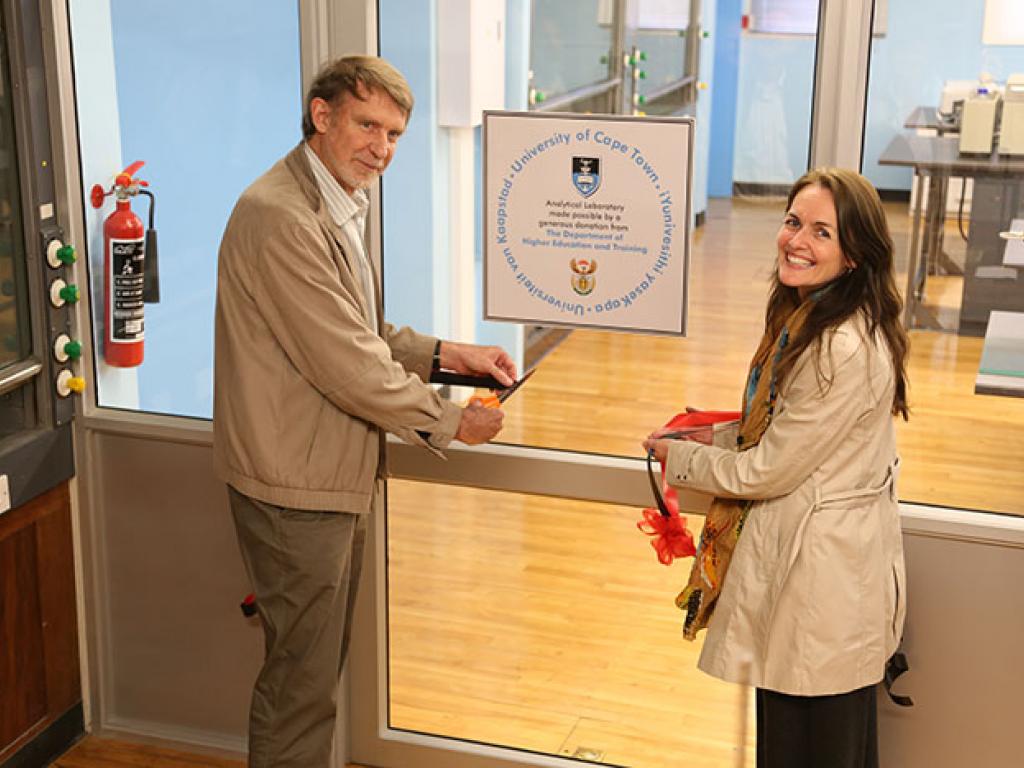'CSI' training for chemistry undergrads in new lab


Dean of Science Prof Anton le Roex and chief scientific officer Claire Lawrence-Naidoo cut the ribbon at the entrance to the Department of Chemistry's new analytical laboratory.
By the time the Zambian scholar arrived in the United Kingdom in 1989 as a Cambridge-Livingstone Trust Scholar in the Department of Chemistry at the University of Cambridge, he was so far behind in basic chemistry laboratory methods that he thought of giving up.
"I rode home in Cambridge on my bicycle every night, wet, lonely and miserable," recalls the director of the South African Medical Research Council Drug Discovery and Development Research Unit, founder and director of the UCT Drug Discovery and Development Centre (H3-D) and full member of the Institute of Infectious Disease and Molecular Medicine (IDM).
It's an important anecdote in an African context as many of UCT's students come from communities that have never been exposed to chemistry laboratories. As a result, they're often underprepared for work in this field.
Chibale says UCT undergraduates now have a distinct advantage over their peers at other institutions.
Thanks to funding from the Department of Higher Education and Training, which has underwritten the new chemistry laboratory, they?re trained in modern analytical techniques used in research and industry.
Chibale's colleague Professor Graham Jackson (who also has roots in Zambia) said: "Most chemical graduates go into analytical chemistry at postgraduate level or go to work in industry.
"But to teach undergraduates chemistry you need expensive, modern equipment of the kind found in Kelly's state-of-the-art drug discovery laboratory with its postgraduate focus."
The new undergraduate facility has changed that.
The new laboratory has two gas chromatography (GC) instruments for the analysis of volatile compounds, like alcohol perfumes for example; a GC coupled to a mass spectrometry (GC-MS), which analyses complex mixtures; a high performance liquid chromatography (HPLC) for drug analysis; a LC-MS for the analysis of complex mixtures of non-volatile compounds; a microwave-plasma atomic emission spectrometer (MP-AES) for measuring the concentration of metals in a solution; and two Fourier transform infrared spectrometers (FTIR), which analyse solids.
"We can now do blood-alcohol analysis for the police forensic laboratory and we can analyse drugs and perfumes – those are the kind of things our students are doing now," Jackson added.
The teaching and learning is rooted in real-world problems and challenges. One of the practicals teaches undergraduates how to monitor groundwater during fracking operations. Another looks at heavy metal contamination of our drinking water.
And it's fun.
For example, third-year forensic chemistry students are given a scenario to work with: a hypothetical murder scene. There's a body but the scene of the crime has been burnt. Was it deliberate? Was the victim drugged? Had they been drinking?
"It's teaching all the experimental techniques in a CSI-type setting," said Jackson. "It makes it more interesting to the students."
And then there's the matter of preparedness of the undergraduates for the world of work.
"If they don't end up in research we're preparing them for industry; we give them a competitive edge when they're applying for jobs," added Jackson.